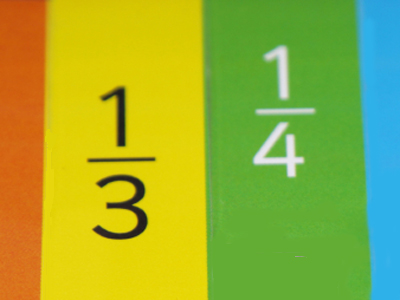
Ask the AI Tutor
Need help with Fractions (Year 6)? Ask our AI Tutor!
AI Tutor - Lucy
Connecting with Tutor...
Please wait while we establish connection

The bottom number of a fraction is called the denominator.
Fractions (Year 6)
In KS2 Maths, Year Six students learn about fractions. Fractions show part of a whole number. There are two types: proper fractions (top number smaller than the bottom) and improper fractions (top number larger than the bottom).
Kids should know numerators and denominators. Improper fractions can become mixed numbers. For instance, 4⁄3 equals 11⁄3. Fractions might seem tricky, but our Fractions in Maths article can help your child understand them better.
Discover the Fun of Learning with Quizzes! Read More
1 .
Which of these are NOT equivalent to each other?
3⁄9 and 1⁄3
6⁄8 and 3⁄4
4⁄6 and 8⁄12
1⁄10 and 2⁄5
1?5 = 2?10
2 .
What would 22⁄6 be when converted to an improper fraction?
14⁄2
15⁄6
14⁄6
13⁄6
14?6 could also be written as 7?3
3 .
Which of these statements is FALSE?
One half is 3 times more than one sixth
One third is twice as much as one sixth
One twentieth is half of one tenth
One hundredth is ten times more than one tenth
One tenth is ten times more than one hundredth
4 .
What would 12⁄9 be when converted to a mixed number?
33⁄9
11⁄3
14⁄9
21⁄9
12?9 could be written as 13?9, 11?3 or 4?3
5 .
What is the numerator?
The top number of a fraction
The bottom number of a fraction
The divider between the two numbers of a fraction
The whole number in a mixed fraction
The numerator tells us how many of the equal parts there are
6 .
How do we change 3⁄10 to an equivalent fraction?
Divide the numerator by the denominator
Divide the numerator and denominator by the same number
Multiply the numerator by the denominator
Multiply the numerator and denominator by the same number
If we multiply by 10 the equivalent fraction will be 30?100
7 .
How many 1⁄1,000 in a whole one?
10
100
1,000
10,000
1,000?1,000 = 1, just as 100?100 or 3?3 = 1
8 .
What do we call the bottom number of a fraction?
Numerator
Factor
Multiple
Denominator
The denominator tells us the number of parts the whole is divided into
9 .
Which is an equivalent of 6⁄15?
2⁄5
3⁄7
2⁄10
1⁄3
6 ÷ 3 = 2 and 15 ÷ 3 = 5 so 2?5 is the same as 6?15
10 .
How do we reduce 5⁄20 to an equivalent fraction?
Divide the numerator and denominator by 2
Divide the numerator and denominator by the same number
Multiply the numerator and denominator by 2
Multiply the numerator and denominator by the same number
We have to find the lowest common multiple of 5 and 20 which is 5 so the equivalent will be 1?4
**Unlimited Quizzes Await You! 🚀**
Hey there, quiz champ! 🌟 You've already tackled today's free questions.
Ready for more?
Ready for more?
🔓 Unlock UNLIMITED Quizzes and challenge yourself every day. But that's
not all...
not all...
🔥 As a Subscriber you can join our thrilling "Daily Streak" against other
quizzers. Try to win a coveted spot on our Hall of Fame Page.
quizzers. Try to win a coveted spot on our Hall of Fame Page.
Don't miss out! Join us now and keep the fun rolling. 🎉
**Unlimited Quizzes Await You! 🚀**
Hey there, quiz champ! 🌟 You've already tackled today's free questions. Ready for more?
🔓 Unlock UNLIMITED Quizzes and challenge yourself every day. But that's not all...
🔥 As a Subscriber you can join our thrilling "Daily Streak" against other quizzers. Try to win a coveted spot on our Hall of Fame Page.
Don't miss out! Join us now and keep the fun rolling. 🎉






